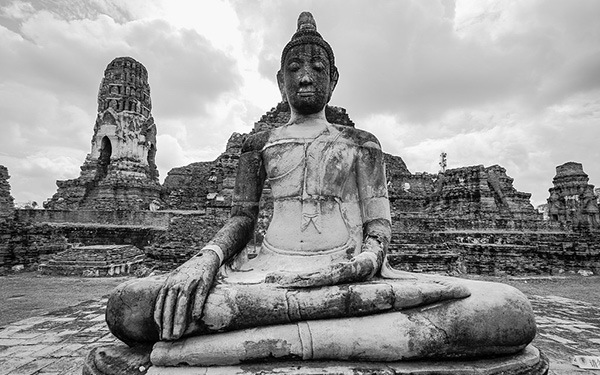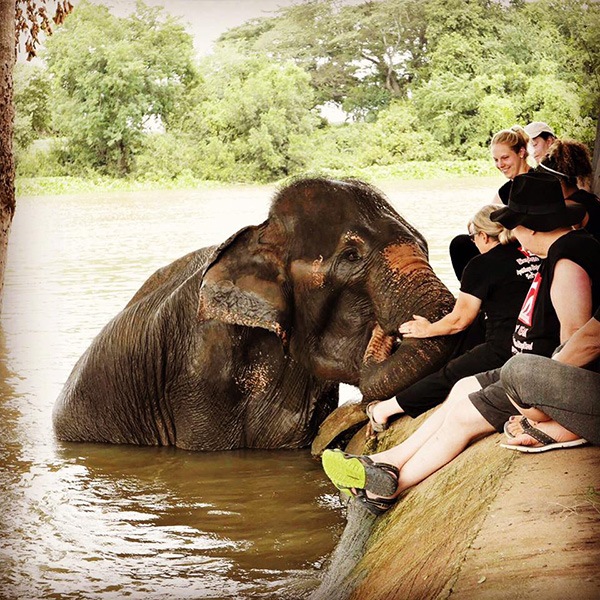It’s dawn, and the sky showers the tips of mysterious stone towers in rich shades of rose and gold – it’s enough to take your breath away.
This is awe inspiring Ayutthaya — the legendary historic kingdom and capital city of Siam in the Central Plains of Thailand, less than 100 km north of the modern Thai capital Bangkok.
This former kingdom of Thailand is just a short journey away from Bangkok, making it perfect for a day trip.
We’ve compiled a quick guide to Ayutthaya, as well as a list of the top sights to see in the city.
Let’s take it away…
Post Contents
Bangkok to Ayutthaya
The easiest way to get to Ayutthaya is by train from Hualamphong Station in Bangkok’s city centre. Alternatively, you can take a minibus from Mo Chit Bus Terminal which costs less than 100 THB, or a van from Victory Monument.
A Brief History of the Ayutthaya Kingdom
The extensive and beautiful ruins of the Ayutthaya Kingdom are all that remains of what was once the Siamese capital city.
Founded in 1350, the city represented the pinnacle of cosmopolitan creativity and inventiveness, and a centre of global trade and diplomacy.
The Ayutthaya civilization at this time was incredibly powerful — particularly during the 14th to 18th centuries when it was at its peak — and the city’s wealth was displayed in the form of sprawling decadent monasteries, towers, palaces and other buildings whose unique architecture took inspiration from other countries all over the world.
Sadly, in 1767 Ayutthaya succumbed to attack by the Burmese, who burnt the city almost to the ground.
However there still remains standing today an extensive and impressive selection of intriguing ruins, and Ayutthaya is now a protected UNESCO world heritage site.
What to See in Ayutthaya
Ayutthaya Historical Park
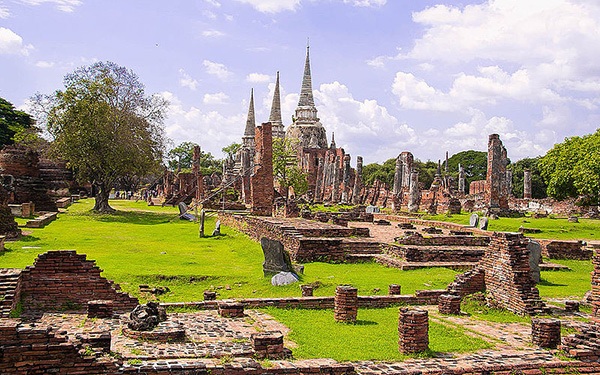
By Ranjithkr (CC BY-SA 4.0 licence)
The main focus of the archaeological sites at Ayutthaya — the Ayutthaya Historical Park- – is situated on an island surrounded by three rivers, and is a UNESCO world heritage center.
There are 95 sites of interest on the island alone, 67 of which are temples (some of which have been restored) as well as other buildings including several royal palaces.
Here’s what’s a ‘must-visit’ within the historical park of Ayutthaya…
Chao Sam Phraya National Museum
During the excavations and renovations at Ayutthaya, many great treasures were unearthed in the crypts of several temples, most of which are now on display at the Chao Sam Phraya National Museum.
Impressive collections of gold, jewellery, wood carvings, stone statues and Buddha images are exhibited here, as well as ceramics, ceremonial items, and glittering royal regalia.
The collection offers an interesting glimpse into the distinct architecture and art of the Ayutthaya civilisation.
The Chao Sam Phraya National Museum is located at the heart of the island at the corner of Rotchana road.
Wat Mahathat
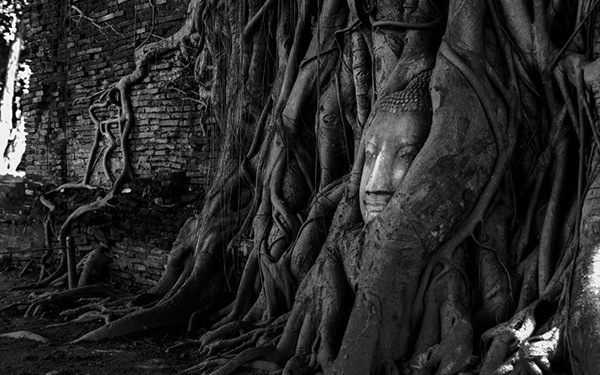
By S.Ken (CC BY 2.0 licence)
Constructed in 1374, Wat Mahathat is one of Ayutthaya’s oldest and most eminent temples.
This temple was the symbolic heart of the city where the Buddha’s relics were enshrined.
It was in the crypt of Wat Mahathat that some of the most important archaeological artifacts were found during the 1950s. It is also believed that the head of the Buddhist monks resided here, and it was here that important royal ceremonies and celebrations took place.
Famous for a mysterious Buddha statue with its face overgrown by tree roots, this temple offers some great photo opportunities.
The temple originally had a large central prang which has sadly since collapsed, but smaller prangs, expansive galleries and other architectural treats remain standing.
Wat Mahathat can be found on the corner of Chi Khun Road and Naresuan Road on the island.
Wat Ratchaburana
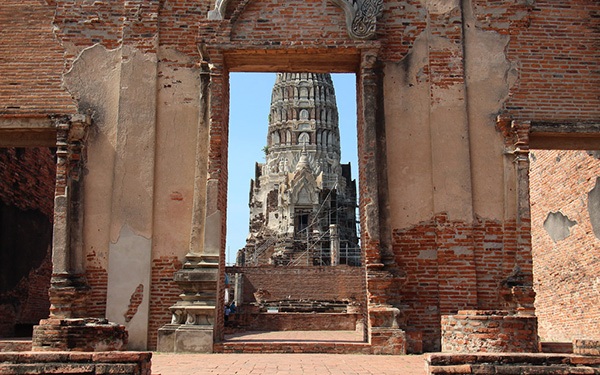
By Connie (CC BY-SA 2.0 licence)
Built some time during the 15th century, Wat Ratchaburana is distinctive due to its huge central prang which juts massively skyward.
Situated opposite Wat Mahathat on the corner of Chi Khun Road and Naresuan Road close to Paa Than bridge, Wat Ratchaburana was also home to many hidden treasures which have since made their way into Chao Sam Phraya National Museum.
Apart from the impressive central prang, this temple features some impressive architectural features, with an ordination hall and a large assembly hall making up part of the complex.
There are also some stunning stucco and carved details still intact.
Wat Phra Si Sanphet
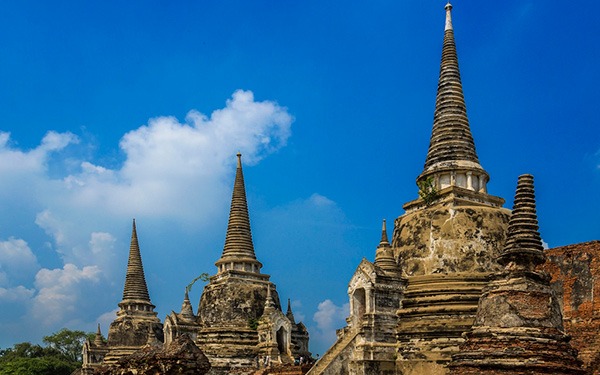
By Guillén Pérez (CC BY-ND 2.0 licence)
On the north west corner of the island sits 15th century temple Wat Phra Si Sanphet, which formed part of the royal palace complex, making it one of the most important temples in Ayutthaya.
Three large chedis shaped like enormous bells sit in a row on a raised platform in the centre of the temple, and these are the burial place of members of the royal family.
There are also the remains of an assembly hall which originally housed a 16 metre tall Buddha statue, an ordination hall, and the surprisingly intact Sala Chom Thong where monks studied the teachings of the Buddha.
Around the temple complex is a great wall with gates to north, south, east and west.
Wat Phra Ram
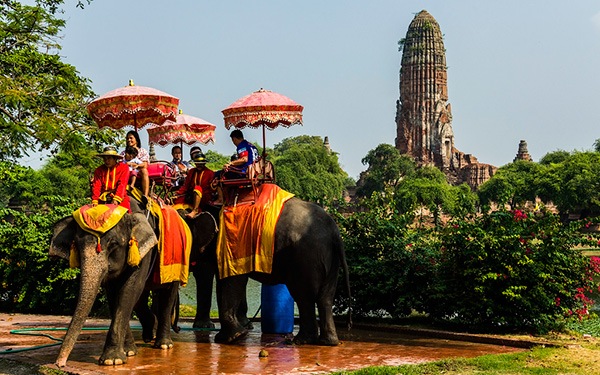
By Guillén Pérez (CC BY-ND 2.0 licence)
Close to Wat Phra Si Sanphet and the Grand Palace is Wat Phra Ram, a 14th century temple constructed on the cremation site of the first king of Ayutthaya.
It features a large Khmer style central prang with mythical creatures on its four corners and smaller towers, galleries and chedis surrounding it.
This picturesque temple is situated next to a large lake where locals come to relax.
Wihan Phra Mongkhon Bophit
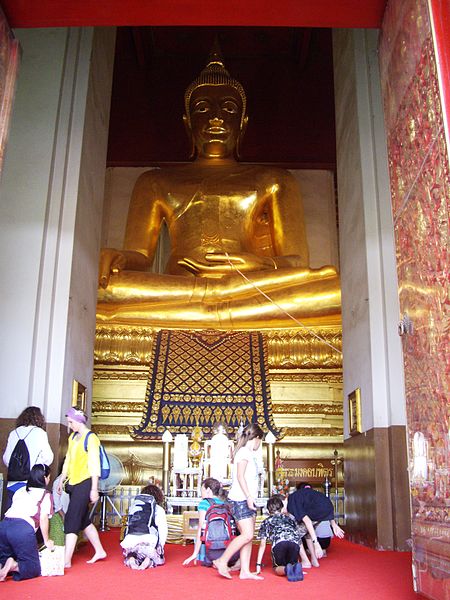
By Ekeidar (CC BY-SA 3.0 licence)
Wihan Phra Mongkhon Bophit is a bustling temple where modern Thais regularly come to worship the enormous Buddha statue named Phra Mongkhonbophit.
The statue was originally commissioned by King Chairachathirat in the 1500s and was moved to its current site in the 1600s. It has been restored several times during its history due to lightning and fire damage.
This immense sitting Buddha measures nearly 10 metres wide and almost 13 metres high, and is completely covered in gleaming gold.
Wat Thammikarat
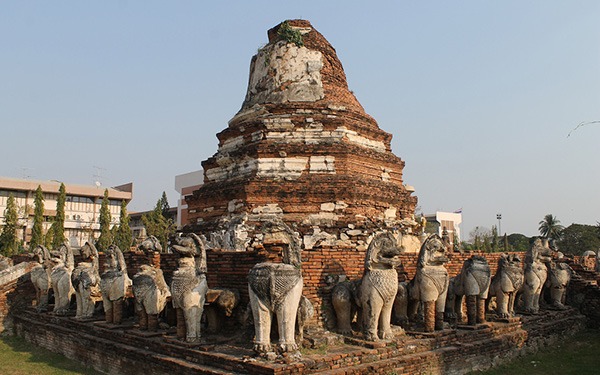
By Connie (CC BY-SA 2.0 licence)
Built before the city of Ayutthaya, Wat Thammikarat is one of the oldest temples in Ayutthaya Historical Park, but amazingly it is still in use today as a functioning monastery.
Wat Thammikarat has been restored numerous times over the centuries, and there are a wealth of mythical sculptures including nagas and lions to be found here.
There is also an impressive 12 metre long reclining golden Buddha decorated with mirror mosaics.
To get here head to the north of the centre where you’ll find Wat Thammikarat situated between Uthong Road and Naresuan Road.
Wat Lokkayasutharam
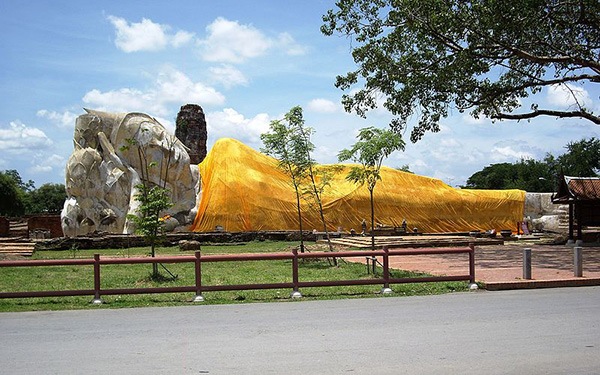
By Ekeidar (CC BY-SA 3.0 licence)
On the western outskirts of the Ayutthaya Historical Park lies an immense reclining stone Buddha 8 metres high.
The Buddha is in the grounds of Wat Lokkayasutharam, which can be accessed by walking down a lane located of off Khlong Tho Road.
Unfortunately there is very little else left of the original temple, but it’s worth making the trip here just to see the magnificent Buddha lounging on a lotus leaf.
Outside the Park
There is even more to explore outside the boundaries of the Ayutthaya Historical Park.
Here are some of the highlights…
Wat Yai Chai Mongkhon
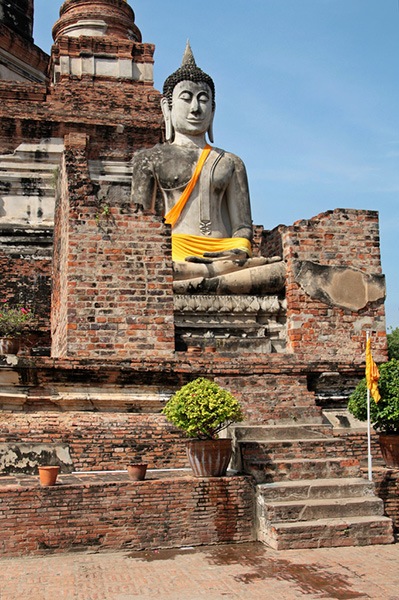
By DavideGorla (CC BY 2.0 licence)
This 14th century temple is one of the key temples of Ayutthaya. Located just a few kilometres east of the island itself, Wat Yai Chai Mongkhon boasts an imposing 60 metre tall chedi tower, inside of which are kept images of the Buddha and other relics.
The main chedi is surrounded by smaller chedis in various states of repair and a remarkable gallery on which are seated hundreds of Buddha statues.
There are numerous other structures on the site, including an ordination hall and a large reclining Buddha. This is a busy temple as monks still live and work here.
Wat Phanan Choeng
At the junction of the Pa Sak and Chao Phraya Rivers to the south east of the island nestles lively Wat Phanan Choeng, which dates to the early 14th century.
The principle draw here is the 19 metre high, gilded seated Buddha which is thought to be even older than the temple itself and as legend has it shed tears just before the sacking and destruction of Ayutthaya city by the Burmese.
There are also other buildings dotted about the temple grounds, including an attractive Chinese style temple which was originally built for a Chinese princess and which is decorated with sculptures of warriors and dragons.
Wat Chaiwatthanaram
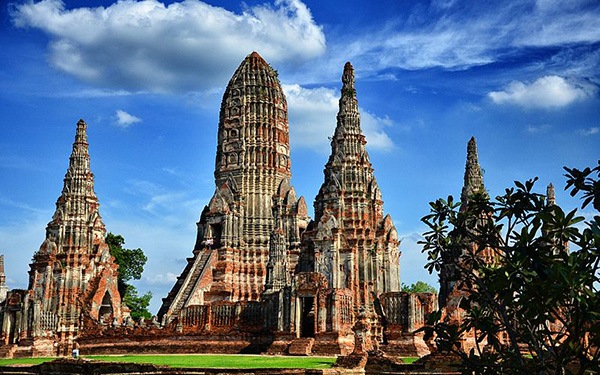
By Jidapa Tansutat (CC BY-SA 3.0 licence)
One of Ayutthaya’s most famous temples, Wat Chaiwatthanaram is a royal temple in the Khmer style.
The ashes of the king who built it in 1630 (King Prasat Thong) are safely entombed in two of the chedis on the site.
A 35 metre high central prang tower is surrounded by smaller towers and a gallery — all of which are remarkably well preserved — and there are some beautiful stone carvings here, as well as the remains of stucco work and painted murals inside the temple itself.
Wat Chaiwatthanaram is situated south west of the island on the banks of the Chao Phraya River, and it is particularly beautiful at sunset or in the evening when the ruins are lit up to reveal an ethereal splendor.
Wat Phutthaisawan
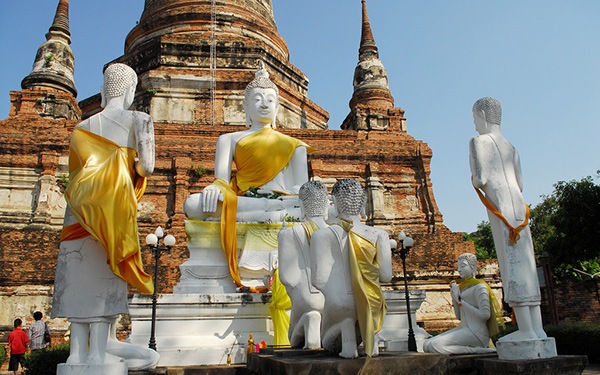
By Thanate Tan (CC BY 2.0 licence)
Once an enormous and influential monastery, Wat Phutthaisawan was constructed under the reign of Ayutthaya’s first king, King Uthong, in 1353.
Here a charming, ancient Khmer style chedi with gallery is situated alongside a contemporary, working temple on the south bank of the Chao Phraya River.
The central prang tower is in incredibly good condition and there are some elaborate gilded carvings and murals still intact inside the crypt.
The prang is enclosed by pretty cloisters filled with seated golden Buddha images. Elsewhere in the complex, there is a fabulously ornate ordination hall and a reclining Buddha statue.
Royal Elephant Kraal
Aside from temples, elephants are one of the biggest tourist attractions in Thailand, and you can meet and get hands on experience with elephants and make a real difference to their lives at ElephantStay — the Royal working elephant village in Ayutthaya.
Run by the Phra Kochabaan Foundation, this royally endorsed project cares for over 60 retired old working elephants and elephants who can no longer work.
Guests at the Royal Elephant Kraal take part in a program that involves living with, caring for and learning about elephants. Every day you will feed, water and bathe your own elephant in the river.
There is also a conservation and breeding program in action here.
Situated on the banks of the Lopburi River in the northern part of Ayutthaya, this large elephant corral can accommodate up to six guests at a time to take part in this unique experience.
Ayutthaya Floating Market
Just outside of the old city walls to the northwest is this glorious floating market.
Colourful and lively and set on the banks of the river lined with wooden walkways and bursting with multicolored blooms, the Ayutthaya Floating Market is an experience not to be missed.
There’s an emphasis here on preserving and promoting Thai arts and culture, so there are plenty of handicrafts and traditional foods on offer sold on floating wooden boats or from traditional wooden houses on stilts.
Every day a theatre performs free Thai dance and song performances to entertain visitors. Despite being a bit of a tourist attraction, the Ayutthaya Floating Market is extremely popular with locals too, and it can get very busy at weekends.
Have you visited Ayutthaya yet?
Featured image is by aotaro (CC BY 2.0 licence)

